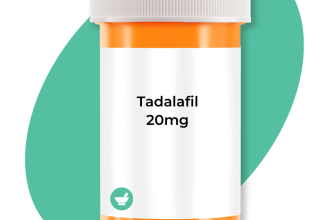If you are dealing with anxiety and depression, exploring a prescription for Paxil might be a suitable step for relief. Paxil, known generically as paroxetine, belongs to a class of medications called selective serotonin reuptake inhibitors (SSRIs). SSRIs help to increase serotonin levels in the brain, which can enhance mood and reduce anxiety.
Consult with a healthcare provider who can evaluate your symptoms and determine if Paxil is appropriate for you. It’s essential to discuss your medical history, including any other medications you are taking. Starting with a low dose may minimize side effects while allowing your doctor to assess your response to the medication.
Side effects can include nausea, headache, fatigue, and sexual dysfunction. While many individuals tolerate Paxil well, be aware that some may experience withdrawal symptoms if the medication is suddenly discontinued. Always follow your doctor’s guidance regarding dosage and duration of treatment to ensure a safe and effective experience.
Incorporating therapy, such as cognitive-behavioral therapy (CBT), alongside medication can significantly improve your mental health outcomes. Engaging in regular exercise and maintaining a healthy diet will also support your overall well-being. Prioritize self-care and remain in close communication with your healthcare team as you navigate this path to recovery.
- Anxiety Depression Paxil Prescription
- Understanding Anxiety and Depression
- Common Symptoms
- Treatment Options
- Significance of Paxil in Mental Health Treatment
- How Paxil Works: Mechanism of Action
- Serotonin Reuptake Inhibition
- Neurochemical Impact
- Proper Dosage and Administration of Paxil
- Adjustments for Special Populations
- Administration Tips
- Common Side Effects of Paxil
- Frequently Reported Side Effects
- Less Common Side Effects
- Potential Interactions with Other Medications
- Monitoring Progress on Paxil: What to Expect
- Long-Term Use of Paxil: Risks and Benefits
- Consultation with Healthcare Professionals: Key Considerations
- Discuss Symptoms Openly
- Inquire About Treatment Options
Anxiety Depression Paxil Prescription
Paxil (Paroxetine) serves as an effective treatment option for managing anxiety and depression. It belongs to the class of selective serotonin reuptake inhibitors (SSRIs), which work by enhancing serotonin levels in the brain, contributing to improved mood and decreased anxiety.
When considering a Paxil prescription, consult your healthcare provider for an individualized assessment. They will evaluate your symptoms, medical history, and any other medications you may be taking to determine if Paxil is the right choice for you.
Monitor your dosage closely. Common initial dosages for adults typically start at 20 mg daily, with potential adjustments based on your response to the medication. This is crucial since each person’s body may react differently to treatment.
Possible side effects include nausea, drowsiness, dizziness, and changes in sleep patterns. It’s important to communicate any adverse effects to your healthcare provider for appropriate management. Most side effects are manageable, but some may require dosage adjustments or a shift to a different medication.
Combining Paxil with therapy can amplify treatment results. Cognitive behavioral therapy (CBT) complements the medication by addressing the underlying thought patterns that contribute to anxiety and depression. Encourage your healthcare provider to explore this option with you.
Consider the duration of treatment. Many individuals may begin to feel improvements within a few weeks; however, it often takes several months to experience the full benefits of Paxil. Stay consistent with your medication schedule, and follow up with your healthcare provider regularly to assess your progress.
| Aspect | Details |
|---|---|
| Mechanism of Action | Increases serotonin levels |
| Initial Dosage | 20 mg daily |
| Common Side Effects | Nausea, dizziness, drowsiness |
| Complementary Treatment | Cognitive Behavioral Therapy (CBT) |
| Timeframe for Results | Several weeks to months for full effect |
Engage openly with your provider about any concerns, and make sure to discuss the potential for tapering off the medication once you achieve stable symptoms. Maintain a supportive network of friends and family to enhance your overall mental health.
Understanding Anxiety and Depression
Anxiety and depression frequently intersect, impacting daily life for many individuals. Recognizing symptoms is the first step toward effective management. Anxiety often manifests through excessive worry, restlessness, or physical symptoms like increased heart rate. Depression may present as persistent sadness, loss of interest in activities, or fatigue.
Common Symptoms
Look for signs such as difficulty concentrating, irritability, and sleep disturbances. These symptoms can diminish one’s quality of life and create barriers to engaging in social or professional activities. Understanding these patterns provides insight into when to seek professional help.
Treatment Options
Consider approaching treatment with a combination of therapy and medication. Cognitive Behavioral Therapy (CBT) effectively addresses both conditions by altering negative thought patterns. Medications like Paxil, an SSRI, can alleviate symptoms and restore balance. Monitoring your response and collaborating with a healthcare provider ensures a tailored approach to treatment.
Significance of Paxil in Mental Health Treatment
Paxil, or paroxetine, serves as a valuable option for individuals dealing with anxiety and depression. It enhances serotonin levels in the brain, leading to improved mood and reduced anxiety. Numerous studies support its ability to alleviate symptoms for those suffering from generalized anxiety disorder (GAD) and major depressive disorder (MDD).
This medication is especially beneficial for patients who may not respond to other treatments. Ideal candidates often experience persistent anxiety or depression impacting daily life. Regular follow-ups with healthcare providers can help monitor progress and adjust dosage as needed to achieve optimal results.
Paxil displays a favorable safety profile, although it does come with potential side effects. Patients commonly report nausea, fatigue, or sleep disturbances. Understanding these risks allows informed decisions about treatment plans. Many individuals find these effects manageable compared to their anxiety or depression.
As part of a comprehensive mental health strategy, Paxil works well alongside therapy, creating a dual approach that tackles both biological and psychological aspects of mental health. Engaging in cognitive behavioral therapy (CBT) while on Paxil often enhances overall effectiveness, leading to sustainable recovery.
Staying patient during the adjustment period is crucial, as benefits may take several weeks to manifest. This timeline highlights the importance of ongoing communication with healthcare providers, ensuring the treatment aligns with individual needs and lifestyle.
For those considering Paxil, understanding its role in managing mental health conditions provides clarity. Its supportive nature, when combined with therapeutic efforts, can guide individuals toward a more balanced and fulfilling life.
How Paxil Works: Mechanism of Action
Paxil, or paroxetine, is a selective serotonin reuptake inhibitor (SSRI) that targets serotonin levels in the brain. By increasing the availability of serotonin, Paxil helps alleviate symptoms of anxiety and depression.
Serotonin Reuptake Inhibition
Paxil primarily works by inhibiting the reuptake of serotonin in the synaptic cleft. This allows for more serotonin to bind to receptors on the postsynaptic neuron, enhancing neurotransmission. The elevation of serotonin levels contributes to mood stabilization and reduced anxiety.
Neurochemical Impact
This medication also influences various receptor sites beyond serotonin, including:
- Dopamine: May affect mood regulation and reward pathways.
- Norepinephrine: Assists in modulating alertness and response to stress.
- Histamine: Could contribute to sedation effects.
These interactions can enhance the overall efficacy in treating anxiety and depressive disorders while potentially mitigating some of the common side effects associated with SSRIs.
Regular monitoring by a healthcare provider is crucial, as the appropriate dosage can vary based on individual response and side effects. Adjustments to the treatment plan can maximize the benefits of Paxil.
Proper Dosage and Administration of Paxil
For adults, the typical starting dose of Paxil (paroxetine) is 20 mg taken once daily, often in the morning. This initial dosage may be adjusted based on individual response and tolerability. The maximum recommended dose can reach up to 50 mg per day, depending on the severity of the symptoms being treated.
Adjustments for Special Populations
For older adults or those with liver impairment, starting with a lower dose, such as 10 mg, is advisable. Gradual increases help to minimize potential side effects. Pregnant or breastfeeding individuals must consult with a healthcare provider to assess the risks and benefits before starting or continuing treatment with Paxil.
Administration Tips
Take Paxil with or without food, but maintain a consistent routine to maximize its effectiveness. Swallow tablets whole; do not chew or crush them. If a dose is missed, take it as soon as possible unless it’s almost time for the next dose. In such cases, skip the missed dose. Do not double the dose to catch up.
Common Side Effects of Paxil
Paxil, known generically as paroxetine, may cause various side effects. Recognizing these effects can help manage them effectively.
Frequently Reported Side Effects
- Nausea: Some users experience gastrointestinal discomfort.
- Drowsiness: This medication can induce sleepiness, affecting daily activities.
- Dry Mouth: A common issue, it may lead to discomfort.
- Insomnia: Conversely, some individuals report difficulty sleeping.
- Weight Changes: Both weight gain and loss are reported; monitor your diet.
- Sweating: Increased perspiration can be bothersome for some.
- Sexual Dysfunction: This includes reduced libido or difficulties achieving orgasm.
Less Common Side Effects
- Blurred Vision: Changes in vision may occur; consult a doctor if this happens.
- Restlessness: Some may feel unusually anxious or restless.
- Headaches: Occasional headaches have been reported by users.
If you encounter side effects that persist or worsen, connect with a healthcare professional. Adjustments to your dosage or medication may be necessary to improve your experience with Paxil.
Potential Interactions with Other Medications
Paxil, a common antidepressant, can interact with several medications, impacting its effectiveness and safety. Always inform your healthcare provider about all medications you’re taking to avoid adverse effects.
Specific categories of medications may lead to significant interactions:
| Medication Type | Interaction Effect |
|---|---|
| Monoamine Oxidase Inhibitors (MAOIs) | Severe hypertension and serotonin syndrome |
| Other SSRIs or SNRIs | Increased risk of serotonin syndrome |
| NSAIDs (e.g., ibuprofen, aspirin) | Increased risk of gastrointestinal bleeding |
| Anticoagulants (e.g., warfarin) | Potentially increased bleeding risk |
| Antiepileptic drugs (e.g., carbamazepine) | Decreased Paxil levels, potentially reducing its effectiveness |
| Narcotics (e.g., oxycodone) | Enhanced sedative effects |
Discuss any planned over-the-counter medications, herbal supplements, or recreational drugs with your healthcare provider, as they can also alter Paxil’s effects. Regularly review your medication routine to ensure optimal treatment outcomes.
Monitoring Progress on Paxil: What to Expect
Track your mood and anxiety levels regularly. Use a journal or smartphone app to note daily changes and triggers. This allows for concrete observations over time and helps recognize patterns that might emerge during treatment.
Expect some side effects during the initial weeks, such as nausea or fatigue. These often subside as your body adjusts to the medication. If side effects persist or worsen, consult your healthcare provider for guidance.
Monitor your sleep patterns as Paxil can affect them. Note any improvements or issues with sleep quality, which plays a key role in managing both anxiety and depression.
Engage with a support system. Whether it’s friends, family, or a therapist, sharing your experiences can provide encouragement and insight. Regular feedback from your network can help you assess the impact of Paxil on your daily life.
Set specific goals related to activities or social interactions. Evaluate your progress in meeting these goals. Improvement in these areas often indicates effective management of symptoms.
Schedule follow-up appointments with your healthcare provider. These meetings are crucial for discussing your progress, medication effectiveness, and any side effects. Adjustments may be necessary based on your feedback.
Be patient. It can take several weeks to notice significant changes in mood or anxiety levels. Consistency in taking your medication and monitoring your progress helps ensure the best outcome.
Long-Term Use of Paxil: Risks and Benefits
Consider long-term use of Paxil carefully, balancing its benefits and potential risks. Patients often experience symptom relief for anxiety and depression, leading to improved quality of life.
- Benefits:
- Reduction in anxiety symptoms significantly enhances daily functioning.
- Improvement in mood contributes to better relationships and productivity.
- Long-term use may stabilize mood disorders, reducing relapse rates.
- Risks:
- Potential for withdrawal symptoms upon discontinuation, including dizziness and irritability.
- Long-term use may lead to weight gain, affecting overall health.
- Increased risk of sexual side effects impacting relationships and personal well-being.
Monitor side effects regularly with your healthcare provider. Adjusting dosage or medication may maximize benefits while minimizing risks. Engage in therapy or counseling as complementary treatments, enhancing the overall effectiveness of Paxil.
Before making any changes to your treatment plan, consult with a healthcare professional. They can provide personalized guidance based on your specific situation.
Consultation with Healthcare Professionals: Key Considerations
Choose a healthcare provider who understands mental health conditions. Look for someone with experience in treating anxiety and depression specifically. This background enhances their ability to suggest appropriate treatments, including Paxil, when necessary.
Discuss Symptoms Openly
Articulate your symptoms clearly during the consultation. Provide details about their frequency, duration, and impact on daily life. Mention any previous treatments or medications you have tried. A detailed account enables the provider to tailor their recommendations to your specific situation.
Inquire About Treatment Options
Ask about potential benefits and side effects of Paxil. Clarify how it works and what to expect during the initial stages of treatment. Discuss alternative options if you have concerns about medication. Be open to a combination of therapies, such as counseling alongside medication, which can enhance recovery.










